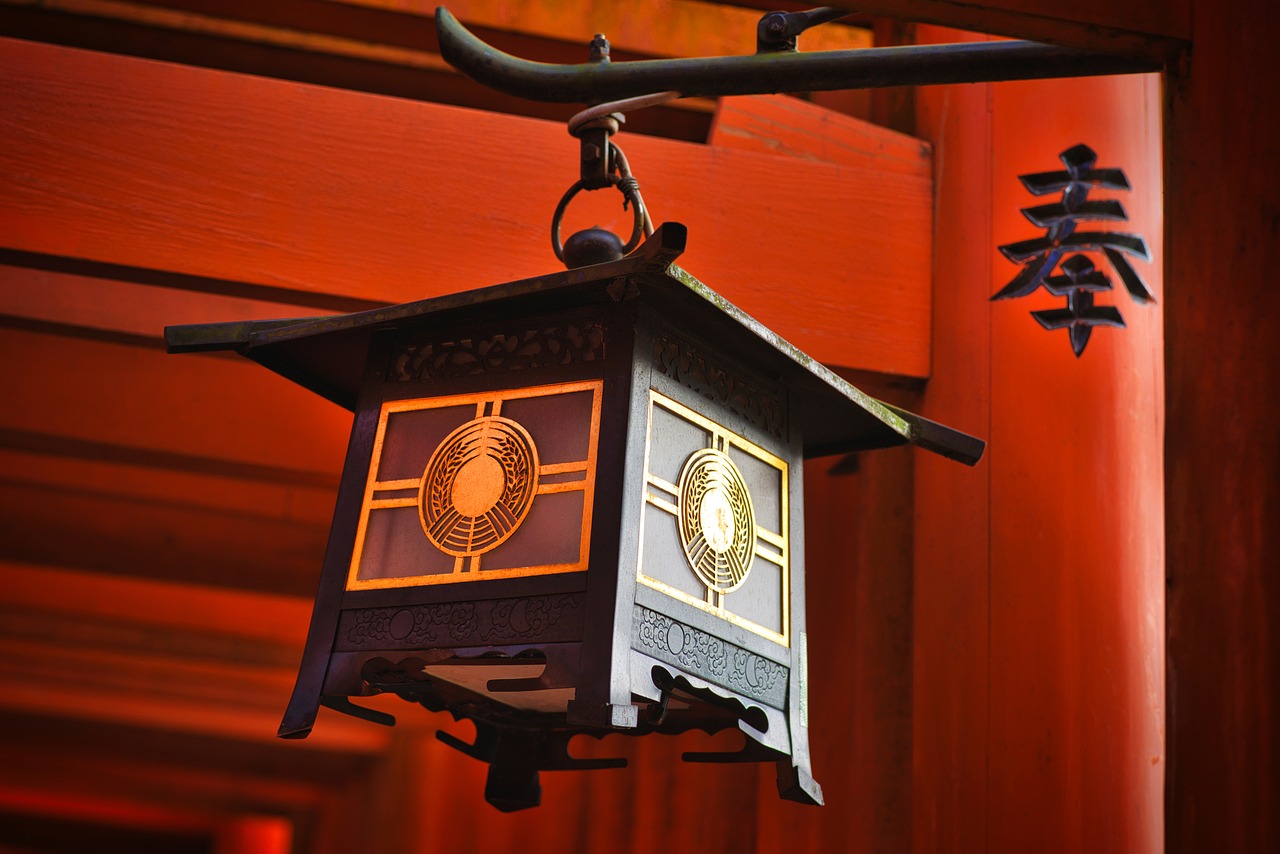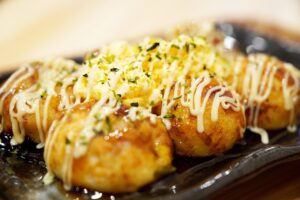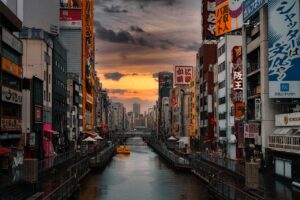Osaka beats with a rhythm all its own. It’s a city of commerce and comedy, of glittering neon rivers and quiet, lantern-lit alleys. Step out of Namba Station, and you’re immediately swept into this current, a dazzling torrent of sights, sounds, and smells. It’s a place that feels relentlessly modern, a concrete and glass jungle where the future seems to arrive every single minute. Yet, hidden within this vibrant chaos, tucked away from the main thoroughfares, are pockets of profound stillness, places where history breathes and ancient spirits seem to watch over the city’s frantic pulse. One such place, a stunning, almost surreal discovery for the unprepared wanderer, is Namba Yasaka Shrine. This is not just another quiet sanctuary; it is home to a guardian, a colossal lion’s head stage that stares out with an intensity that stops you in your tracks. This is where our journey begins, in the shadow of this magnificent beast, a place that captures the soul of Osaka’s surprising duality. But a journey through Osaka is never just about spiritual nourishment; it is also about feeding the body. The city, famously known as Japan’s Kitchen, offers a feast for every palate. And for the Muslim traveler, a delightful and ever-growing world of Halal cuisine awaits, ready to complete the experience. This guide is a passage from the sacred silence of the shrine to the savory warmth of the city’s best Halal kitchens, a pilgrimage of spirit and taste through the heart of Namba.
After exploring the spiritual side of Namba, you can continue your journey by discovering the area’s vibrant Halal food scene in Den Den Town.
The Roar of the Lion: Encountering Namba Yasaka Shrine
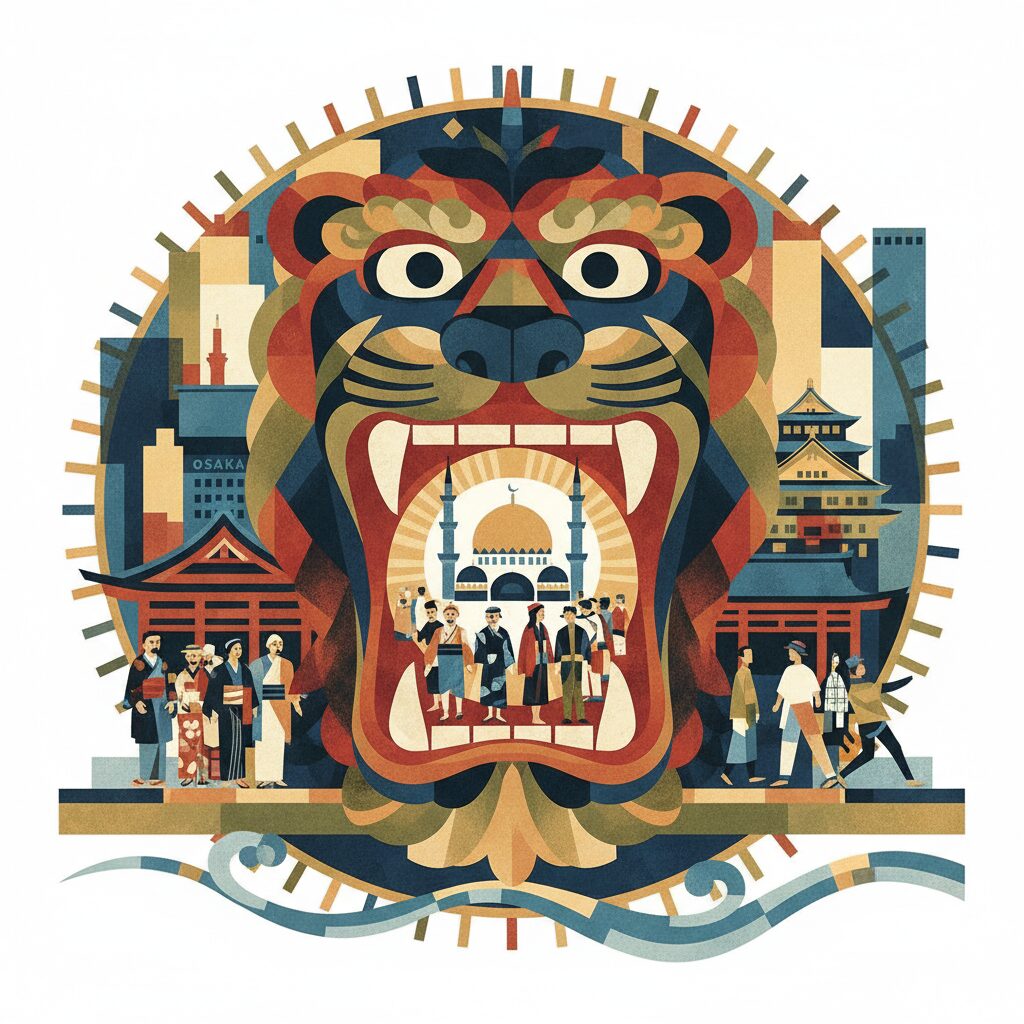
Discovering Namba Yasaka Shrine is like embarking on a brief urban adventure. You step away from the expansive, bustling streets of Namba Parks and the crowded covered shopping arcades, venturing into a network of quieter residential lanes. Here, the atmosphere shifts—the city’s roar softens to a gentle murmur, and the scent of department store fragrances gives way to the subtle essence of everyday neighborhood life. Then, almost unexpectedly, it appears. Beyond a stone torii gate and rising above the tiled rooftops of nearby buildings, the unmistakable outline of a lion comes into view.
A Sudden Calm Within the Urban Sprawl
Crossing into the shrine’s grounds feels like entering another realm. The air cools noticeably. The gravel beneath your feet emits a gentle crunch, replacing the hurried steps of the city streets with a softer tempo. The outside world—with its traffic, announcements, and unending energy—fades into a distant hum. Here, a profound, resonant silence dominates, broken only by the soft cooing of pigeons and the rustling leaves of ancient camphor trees standing like quiet guardians. This powerful shift refreshes your senses, preparing you for the central experience. The stillness is essential, a tribute to the Japanese talent for carving out havens of peace amid modern chaos. It’s a space to pause, breathe deeply, and center yourself before facing the shrine’s awe-inspiring focal point.
The Ema-Den: A Gaze that Devours Misfortune
Then comes the full reveal. The Ema-den, or lion stage, is a stunning architectural feat—sacred art that is both fearsome and beautiful. Towering twelve meters tall and eleven meters wide, it asserts a commanding presence. This is no ordinary statue. It is a structure, a functional stage for ceremonies and performances, shaped as a lion’s head with its mouth eternally agape in a silent roar. Its eyes, painted in radiant gold, seem to track your movements—both piercing and protective. The sharp, gleaming teeth serve a purpose beyond decoration; they play a spiritual role. The vast mouth is said to swallow evil spirits, consume misfortune, and clear the way for good fortune and success. For this reason, students pray here for exam victories, while businesspeople seek prosperity, hoping the great lion will devour any obstacles before them. As a photographer, I find it endlessly captivating. Its immense scale challenges the frame, but the true mastery lies in capturing its spiritual gravitas. The light shifts across its sculpted form throughout the day, revealing countless moods. In the bright morning sun it appears fierce and warrior-like; in the soft late afternoon glow, it takes on a contemplative, wise-guardian air.
Beyond the Lion’s Head
Although the lion stage draws most of the attention, the rest of the shrine grounds offer a quieter, more traditional beauty. To one side stands the Honden, the main hall, a classic shrine building with clean wooden lines, sloping roofs, and delicate carvings. This is the spiritual heart of the shrine, where the resident deity, or kami, is enshrined. Here, the mood is somber and reflective. Visitors participate in prayer rituals: tossing coins, clapping hands briskly to awaken the gods, and bowing deeply in respect. Nearby, a massive, centuries-old camphor tree lifts its twisted branches skyward. A sacred rope decorated with white paper zig-zags, a shimenawa, encircles its trunk, marking it as a shinboku—a tree believed to house a divine spirit. Standing beneath it connects you to the shrine’s long, continuous history, one that predates the surrounding concrete city. Scattered across the grounds are smaller auxiliary shrines, each dedicated to different deities providing blessings for everything from safe childbirth to artistic talent. The charm of Namba Yasaka Shrine lies in this layering of experiences: you arrive for the spectacular lion but remain captivated by the quiet grace that permeates the entire site.
A Photographer’s Perspective: Capturing the Spirit of the Shrine
From a visual perspective, Namba Yasaka Shrine is a treasure. It provides a compelling lesson in contrast, which lies at the core of striking photography. There is the stark, bold, almost pop-art vibe of the lion’s head, set against the natural, subdued, and traditional textures of the main shrine building and the ancient trees. Capturing this contrast is essential. My first suggestion is to arrive early. The morning light, especially on a clear day, is enchanting. It flows in from the east, illuminating the lion’s golden eyes and casting long, dramatic shadows that highlight its three-dimensional form. You can photograph the stage when it is empty, letting its powerful presence fill the frame without distractions. This is the ideal time for quiet, architectural shots.
As the day unfolds and visitors appear, the photographic story evolves. The human element becomes crucial. Don’t just photograph the lion; capture people interacting with it. A child gazing up in wide-eyed awe, an elderly woman engaged in a quiet prayer, a group of friends posing for a selfie—these moments express what this place signifies to people today. Switch to a longer lens to discreetly capture these candid interactions from a respectful distance. Seek out the small details that contribute to a broader narrative. The rows of wooden ema plaques, each inscribed with a handwritten wish or drawing. The intricate knot of a shimenawa rope. The texture of moss growing on a stone lantern. The curling and fading of incense smoke in the air. These poetic details transform a simple travel photo into something more evocative. Experiment with different angles. Lower your perspective and shoot upwards to emphasize the lion’s towering height and imposing presence. Find a side view where you can frame the lion’s profile against the delicate roofline of the main hall in the background. Each angle reveals a new aspect of its character. The shrine is a dynamic subject, and the best way to honor it is to move around it, observe it from every angle, and patiently wait for the perfect moment when light, shadow, and human spirit come together.
The Rhythm of Ritual: Understanding the Shrine’s Pulse

To fully appreciate Namba Yasaka Shrine, it helps to grasp the currents of history and tradition that flow through it. It is not a mere museum exhibit; rather, it is a vibrant center of community faith and culture, with a story deeply intertwined with that of Osaka itself. Its origins are ancient, though the exact date has been lost over time. For centuries, it served as the guardian shrine of the Namba area, where locals came to pray for protection and abundant harvests. Like much of Osaka, the shrine was heavily damaged during the World War II air raids, and its historic buildings were consumed by flames. The post-war reconstruction gave rise to the striking lion stage, completed in 1975. This act of rebuilding stands as a powerful symbol of Osaka’s resilience and forward-looking spirit. Instead of simply replicating the past, the community chose to create something new and unforgettable—a bold statement of identity that has become a city icon.
When the Lion Comes Alive: Festivals and Events
While a visit on any day is rewarding, experiencing the shrine during a festival is witnessing its spirit come alive. The most renowned event is the Tsunahiki Shinji, or Tug-of-War Ritual, held on the third Sunday of January. This lively festival celebrates the myth of Susanoo-no-Mikoto, the shrine’s main deity, defeating the eight-headed serpent, Yamata-no-Orochi. A massive rope, crafted to resemble the serpent, serves as the centerpiece of the ritual. Hundreds of participants, divided into two teams, pull on the rope in a symbolic struggle—a prayer to ward off pestilence and invite good fortune for the year. The atmosphere is electric. The air rings with shouts of encouragement, the rhythmic beating of drums, and a strong sense of communal spirit. It’s a spectacular sight, a living piece of folklore connecting today with Japan’s ancient myths. Even if you miss this major event, smaller rituals and the steady flow of daily visitors ensure the shrine hums with a quiet energy year-round. During New Year’s, Shichi-Go-San in November, or cherry blossom season, the grounds take on an especially festive and beautiful ambiance.
Practical Pilgrim’s Notes
Getting to Namba Yasaka Shrine is surprisingly easy, thanks to its central yet somewhat hidden location. From any major Namba station—Nankai Namba, JR Namba, or the subway Namba Station on the Midosuji, Yotsubashi, or Sennichimae lines—it’s a pleasant 10 to 15-minute walk. Navigating with a map app is simple, and the walk itself offers a nice way to unwind after the bustle of the station. The shrine is open to the public with no admission fee, making it an accessible and worthwhile stop on any Osaka itinerary. For timing, early morning offers solitude and the best light for photography, while midday brings more visitors, providing a chance to see the shrine as a living place of worship. It’s generally advisable to avoid visiting very late at night out of respect for the site’s sanctity. When you visit, keep in mind some basic shrine etiquette. At the entrance, you’ll find a stone basin with running water called a chozuya for purification. Use a ladle to pour water over your left hand, then your right, then pour a little water into your cupped left hand to rinse your mouth—be sure to discreetly spit the water onto the ground, not back into the basin. When approaching the main hall to pray, a simple bow before and after is a sign of respect. These small gestures aren’t mandatory for visitors but show an appreciation of local culture and the sacred nature of the site.
The Journey Continues: From Spiritual Nourishment to Culinary Delights
After spending an hour or two in the calming presence of Namba Yasaka Shrine, soaking in its history and distinctive atmosphere, a different kind of need begins to emerge. The quiet reflection shifts to a pleasant hunger, and the mind moves from the spiritual to the sensory. This is the ideal moment to move on to the next phase of your Osaka journey, as you find yourself in the heart of one of the world’s greatest food cities. The nickname Tenka no Daidokoro, or “The Nation’s Kitchen,” is truly fitting. Osaka’s identity is deeply connected to food and the culture of kuidaore—eating until you drop. For Muslim travelers, this culinary haven is now more accessible than ever. A passionate and expanding community of restaurateurs is committed to offering delicious, authentic Japanese cuisine that strictly follows Halal principles. Searching for a Halal meal in Osaka isn’t a chore; it’s an adventure—a treasure hunt leading you to some of the city’s most welcoming and flavorful spots. Leaving the peaceful shrine grounds and stepping back into the lively streets of Namba, you’re perfectly placed to begin this tasty quest.
A Taste of Osaka, Halal-Certified: The City’s Welcoming Kitchens
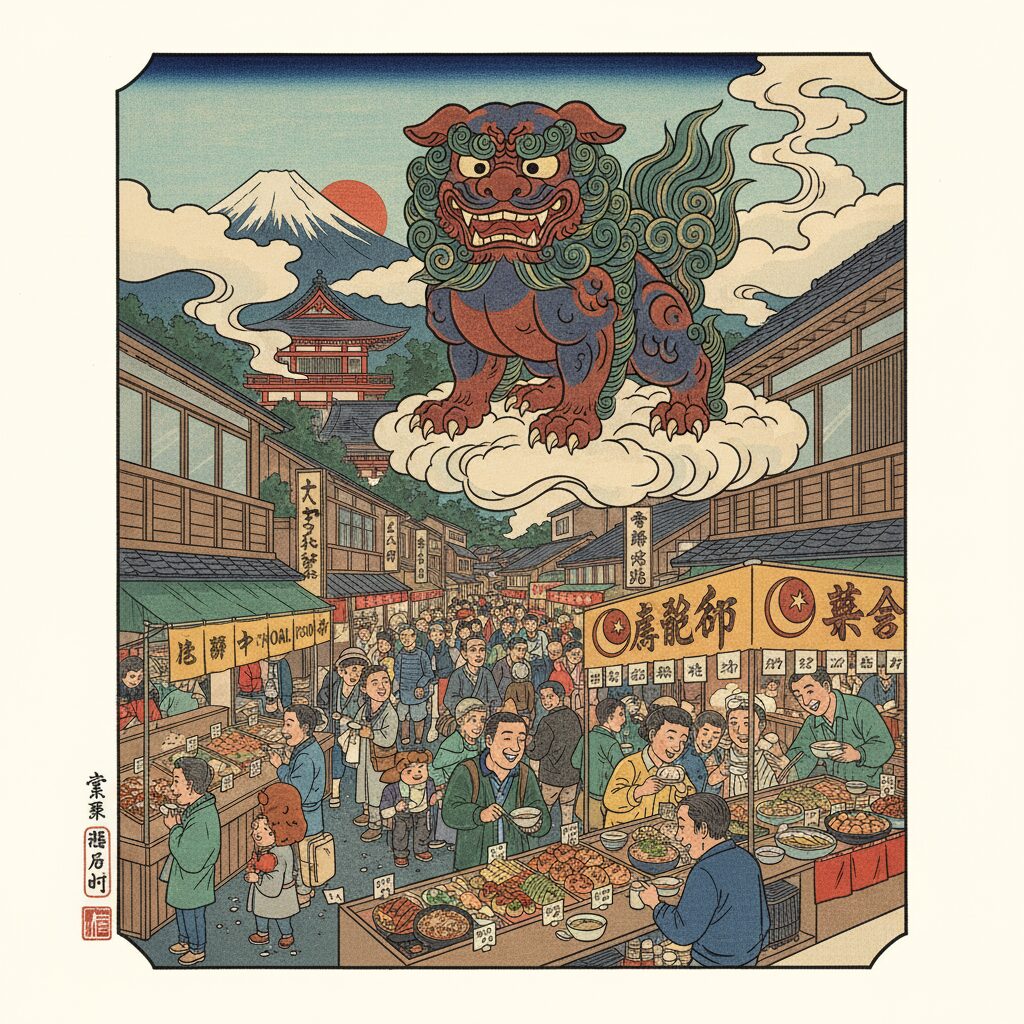
The area around Namba is an excellent starting point for your Halal food adventure. Numerous restaurants here cater to Muslim diners, offering everything from traditional Osaka street food to comforting bowls of ramen. Each establishment has its own distinct charm, yet all share a dedication to quality, authenticity, and warm hospitality. Let’s take a look at a few standout spots that are easily accessible after visiting the shrine.
Restaurant 1: Matsuri – The Ultimate Halal Dining Experience
A short walk or a brief train ride from Namba Yasaka Shrine brings you to Matsuri, a restaurant well-known for Halal Japanese cuisine in Osaka. The name, meaning “festival,” perfectly matches the lively and welcoming atmosphere inside. The place is bright and bustling with a cheerful mix of international tourists and local Japanese guests. The staff are exceptionally friendly and fluent in English, making visitors feel immediately comfortable. What makes Matsuri truly remarkable is the extensive variety on its menu. It offers a one-stop destination for all the iconic Osaka and Japanese dishes you’ve been eager to try. Their Halal Takoyaki is a must-try—delicious doughy balls filled with tender octopus, cooked fresh in a special cast-iron pan right before your eyes, topped with a sweet-savory Halal takoyaki sauce, Japanese mayonnaise, and bonito flakes that dance with the heat, delivering a genuine taste of Osaka. The menu doesn’t stop there; they also serve a superb Okonomiyaki, Osaka’s famous savory pancake, arriving sizzling on a hot plate with your choice of fillings. For those craving noodles, the Halal Ramen is rich and flavorful. They also offer a variety of other dishes, from karaage (Japanese fried chicken) to gyoza. What truly distinguishes Matsuri is its commitment to the Muslim community, including a dedicated prayer room on site, allowing diners to observe prayer times comfortably. Additionally, the restaurant doubles as a small grocery store, selling Halal-certified Japanese ingredients, snacks, and souvenirs such as Halal soy sauce, ramen kits, and sweets to bring a taste of Osaka home. Dining at Matsuri is more than a meal—it’s an experience that connects you to the local Halal community with genuine warmth.
Restaurant 2: 3 te cafe – A Fusion of Spice and Japanese Elegance
For a different atmosphere, a short trip takes you to 3 te cafe (pronounced ‘Sante Cafe’), a charming spot that blends Japanese aesthetics with a cozy, international vibe. It’s a relaxed cafe-style environment where you can sit back and enjoy a thoughtfully prepared meal. While the menu offers a range of dishes, they are especially known for their exquisite take on Japanese curry and their Halal Kobe Beef, a true premium experience. Their Japanese curry is exceptional—milder and sweeter than many South Asian or Southeast Asian curries, with a thick, velvety sauce that is both comforting and complex. Served over fluffy Japanese rice with choices like crispy chicken katsu, it exemplifies yoshoku—Western-influenced Japanese cuisine—done to perfection. The highlight for many is the chance to savor one of the world’s most renowned meats in Halal form. The Kobe beef at 3 te cafe is prepared with great care, often served as steak or in other luxurious styles. Known for its intricate marbling, it boasts a buttery tenderness and rich, delicate flavor that is unforgettable. Though an indulgence, this is a culinary experience many Muslim travelers thought impossible in Japan. The owners’ passion shines through each dish as they diligently source the best Halal ingredients and apply classic Japanese cooking techniques, creating a menu that is both authentic and innovative. This place shows that Halal dining in Japan is about expanding culinary horizons, not making compromises.
Restaurant 3: Ramen Honolu – A Bowl of Halal Comfort
Ramen is Japan’s soul food, yet for many years, finding an authentic Halal version was challenging due to pork-based broths and ingredients central to traditional recipes. Ramen Honolu, with a branch conveniently located in Namba, has masterfully addressed this. Stepping into Honolu feels like entering a classic ramen-ya: a compact, lively space filled with the inviting aroma of simmering broth and the joyful sounds of slurping noodles. Their focus is clear—to craft the most delicious Halal ramen possible. Their signature dish is the Tori Paitan ramen, which features a rich, creamy chicken broth made by simmering chicken bones for hours to create a milky, collagen-rich soup packed with umami. The noodles are perfectly springy, topped with tender chicken char siu (prepared without pork or non-Halal seasonings), a perfectly soft-boiled egg with a jammy yolk, crisp bamboo shoots, and fresh green onions. They often offer a spicy version for those wanting a little heat. Every spoonful bursts with textures and flavors that are warm, savory, and deeply comforting—the kind of meal that feels like a hug in a bowl. For many Muslim visitors, enjoying their first authentic bowl of ramen at Honolu is a trip highlight, offering a chance to partake in a beloved Japanese culinary tradition in full respect of their faith. Sitting at the counter, watching the chefs skillfully prepare your bowl, and then savoring the steaming, fragrant masterpiece is an unforgettable experience.
Beyond the Plate: Navigating Namba’s Culinary Landscape
These restaurants are just the beginning. Osaka’s Halal food scene is vibrant and continually evolving. As a traveler, a few tips can help you confidently navigate this exciting culinary landscape.
Tips for the Halal Traveler in Osaka
First, understand the difference between “Halal-certified” and “Muslim-friendly.” Halal-certified restaurants, like those mentioned above, have been officially approved by a certifying organization. They use entirely Halal ingredients, maintain dedicated Halal kitchens, and often offer prayer facilities. “Muslim-friendly” is a broader category, which might indicate a restaurant that avoids pork but serves alcohol, or one with a Halal menu option prepared in a shared kitchen. Always feel free to ask questions politely—most restaurateurs catering to Muslim diners are open and happy to explain their practices. Technology can also be a valuable resource. Several helpful apps and websites specialize in locating Halal food in Japan. A quick search before your trip will give you an updated map of options. Lastly, don’t hesitate to explore beyond Japanese cuisine. Osaka’s large international community means you can find excellent Halal dishes from Turkish, Indonesian, Pakistani, and other cuisines, especially around Shinsaibashi and the Namba district.
Exploring the Neighborhoods
Combining your dining experiences with exploration is the best way to enjoy Osaka. After a satisfying meal at Matsuri, you’re well situated to head north into the Shinsaibashi-suji Shopping Arcade, a seemingly endless covered street filled with all kinds of shops. From there, it’s a short walk to the renowned Dotonbori district. After enjoying ramen at Honolu, take a stroll toward Dotonbori to see the iconic Glico Running Man sign and the dazzling neon billboards that light up the night and reflect in the canal below. The area around Namba Yasaka Shrine is also worth a deeper look. Explore the quirky shops of Amerikamura (America Village) or the electronics haven of Den Den Town. Each meal becomes the starting point for a new adventure, allowing you to weave a journey through Osaka that satisfies both your palate and your curiosity.
A Final Reflection: The Echo of the Lion’s Roar
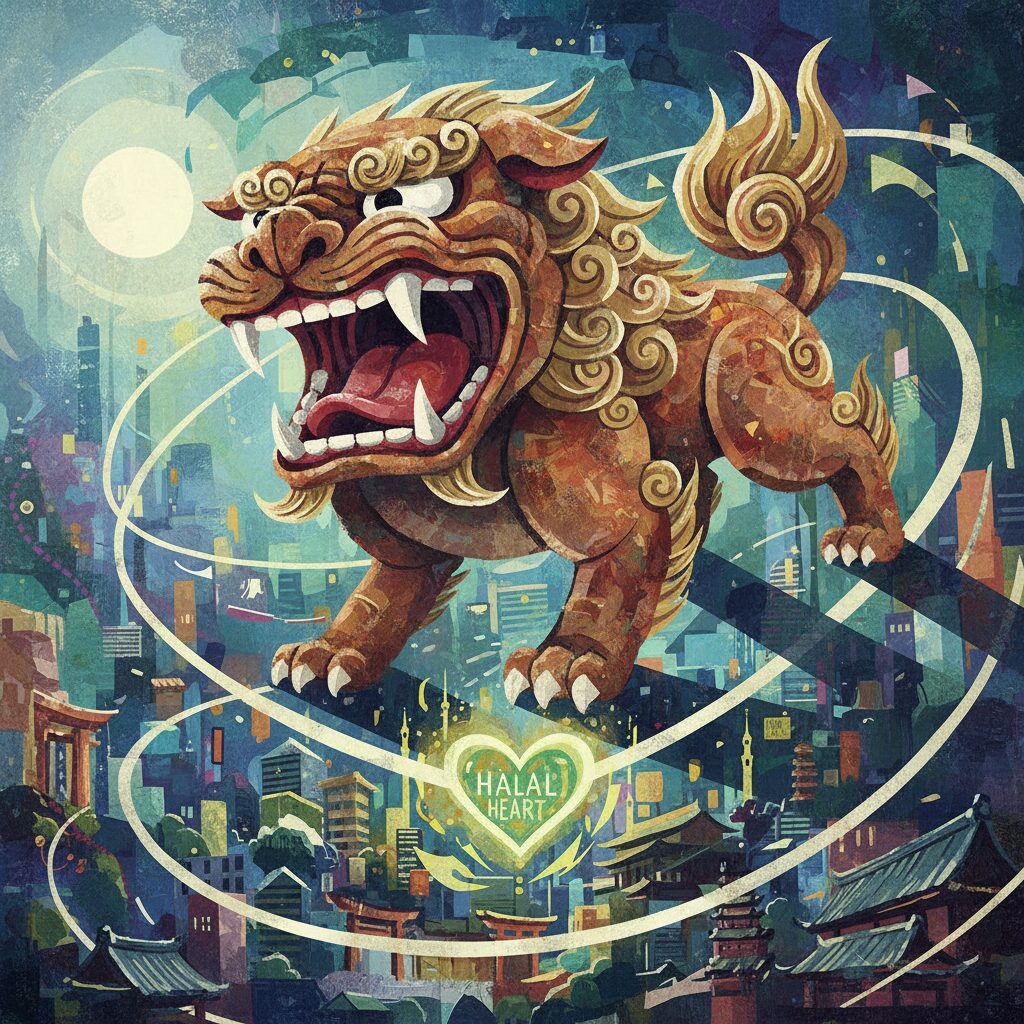
An afternoon in Osaka can be a journey filled with striking contrasts. It may begin in the sacred quiet of Namba Yasaka Shrine, where you stand before a guardian lion whose silent roar seems to absorb all the outside world’s chaos, leaving you with a sense of peace and protection. In that tranquil space, you connect with a deeper, more ancient essence of Japan. Then, the journey can lead back into the vibrant, pulsating heart of the city, into the warm embrace of a restaurant where the nation’s culinary soul is generously shared with respect for your faith. The sizzle of takoyaki on the grill, the rich aroma of simmering ramen broth, and the laughter shared over a delicious meal—these moments hold a different kind of sacredness. They celebrate connection, hospitality, and the universal joy of sharing good food. Osaka doesn’t require you to choose between its ancient traditions and modern pleasures, or between spiritual fulfillment and sensory delight. It offers them all simultaneously. The echo of the lion’s roar stays with you, not as a sound, but as a feeling—a feeling of being protected, welcomed, and truly, wonderfully nourished in body and spirit.
